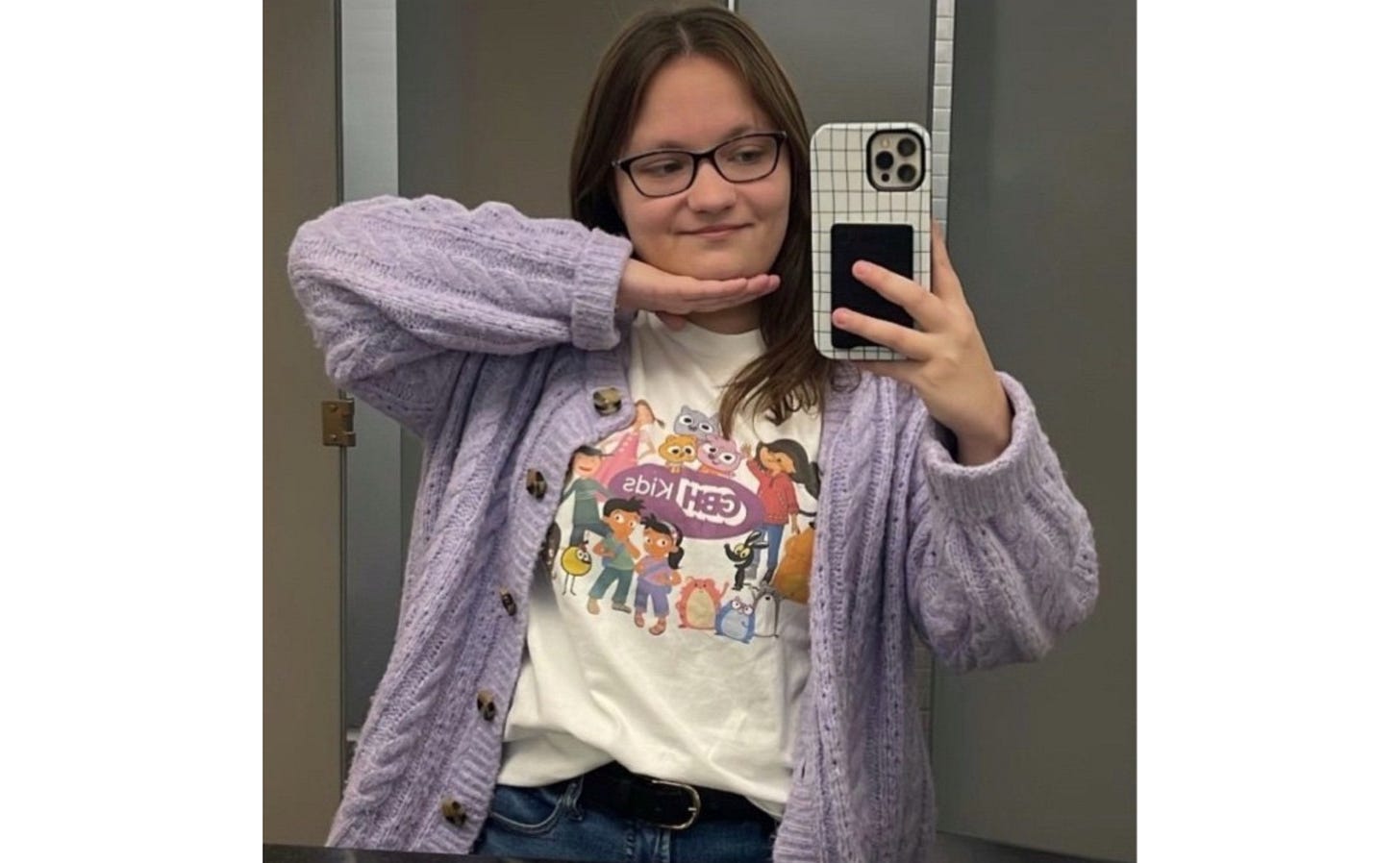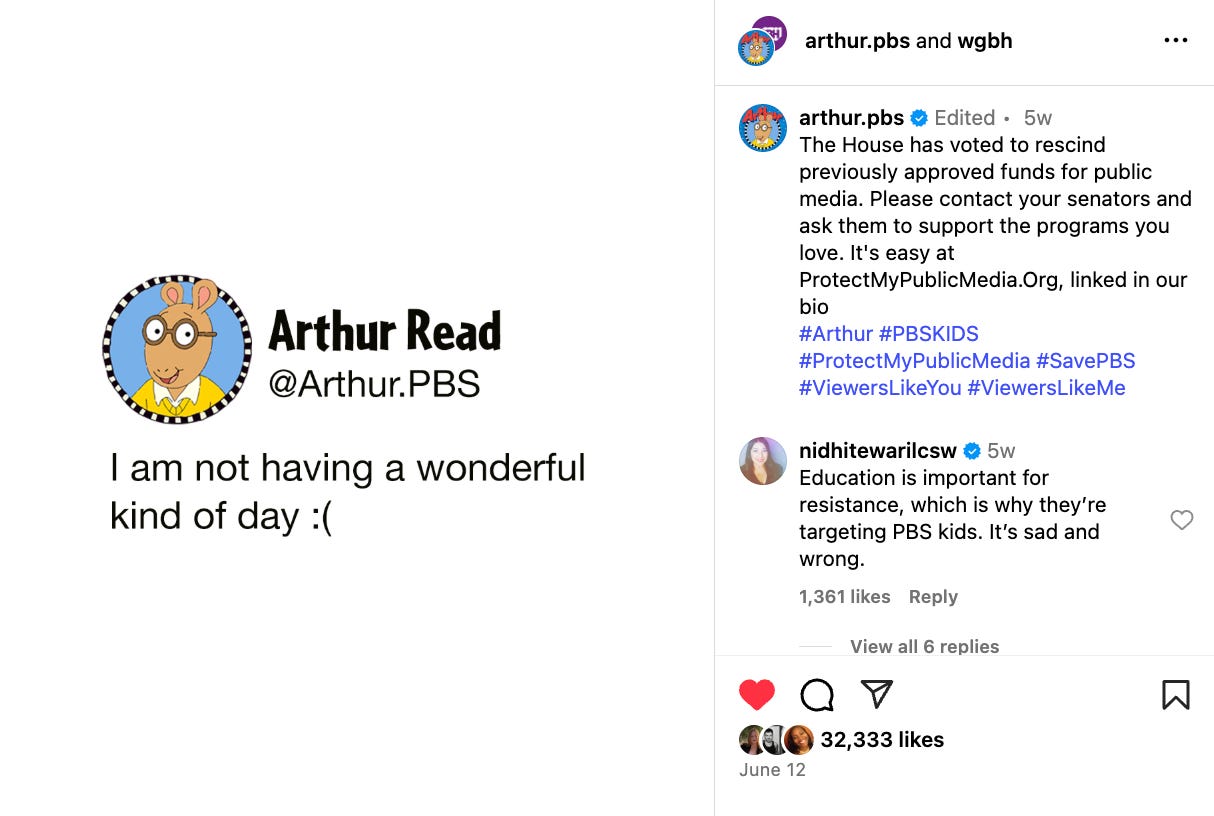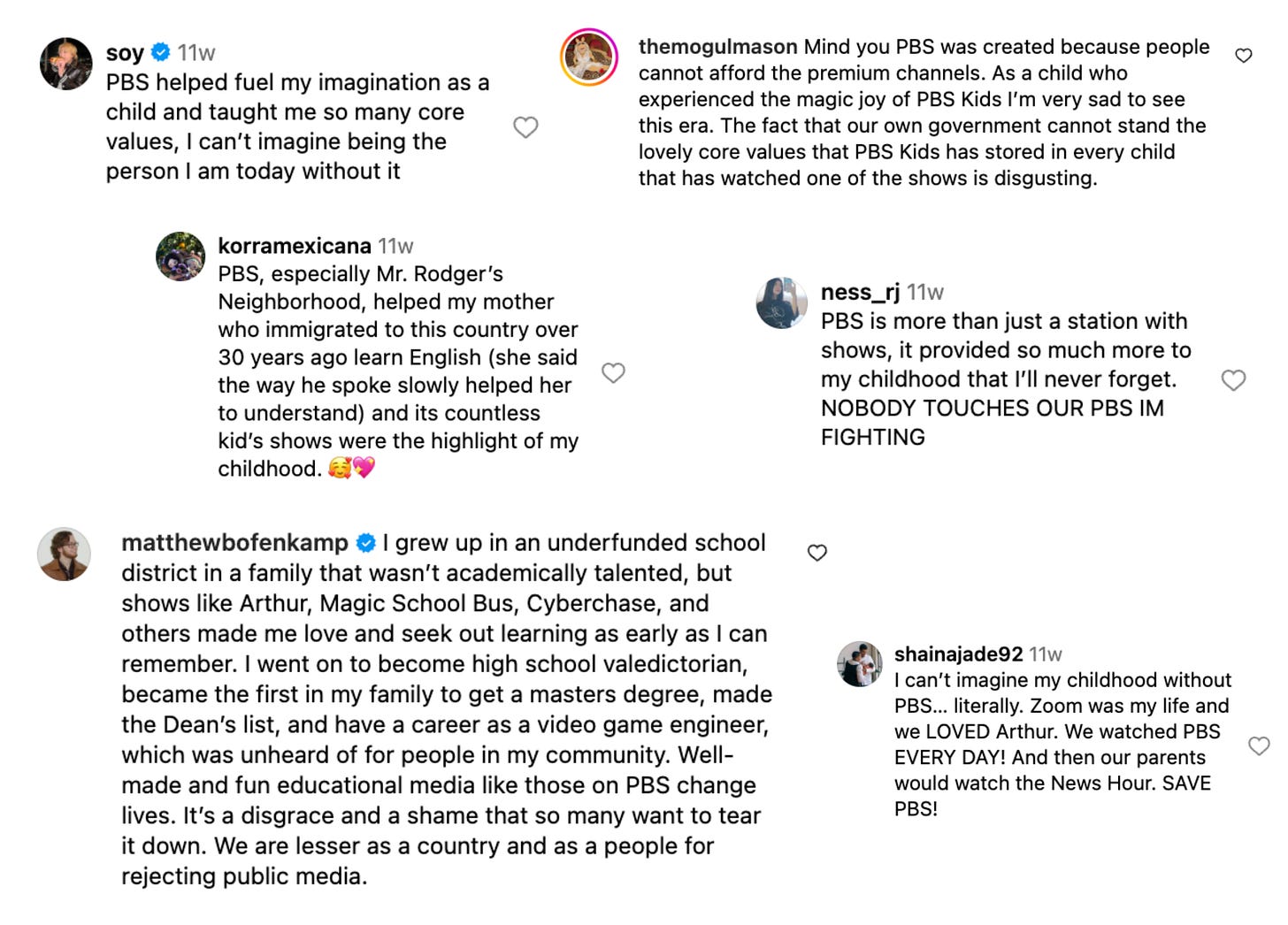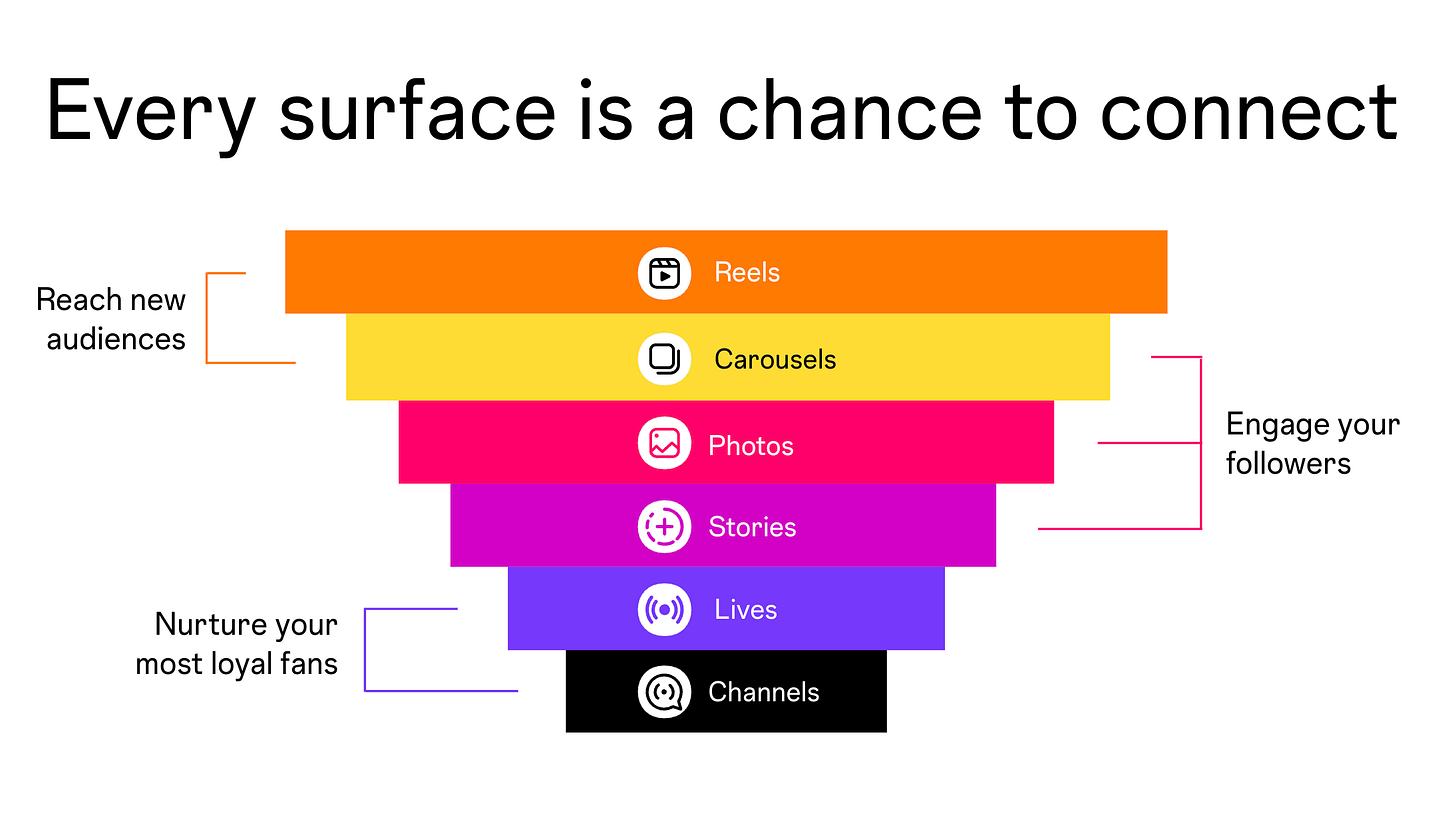Why Arthur finally posted the fist meme
The PBS KIDS show is using social media to protect and restore public media funding.
In the early hours of July 18, congress voted to strip $1.1 billion in already-approved funding for public media. It’s a devastating move that jeopardizes the essential services these stations provide to communities nationwide.
During the lead up to these cuts an unlikely activist emerged: Arthur Read, the 8-year-old Aardvark main character of the book and television series Arthur. The official account for the PBS KIDS show has been using memes and clips to message and organize around the funding cuts. One post with the infamous fist meme garnered over 350K likes.
In today’s newsletter I am speaking with Cathleen Cusachs, social media manager for GBH Kids and person behind the @ArthurPBS accounts. GBH is the largest producer of PBS programs in the country, and the home of popular PBS KIDS brands like Arthur, Molly of Denali, Pinkalicious & Peterrific, Work It Out Wombats!, and so many more.
We talk about leaning into lore, why they “wielded the power of the fist” for the first time ever, and how they drove over 15,000 clicks to Protect My Public Media.
Sponsored by Slate
The content creation platform made for social teams
What do social accounts like Amazon, New York Knicks, and Vanity Fair have in common? They all use Slate to level up their content, enhance their real-time coverage, and speed up their workflows.
Here are a few of my favorite Slate features:
The Content Hub is a repository of all of your created content—organized and accessible at your (and your team’s) fingertips
Quickly auto-caption video content using your brand fonts and colors
Shortcuts uses AI to finds the best moments in your long-form video and creates ready to post edits for every social feed
Social safe zones to ensure your content fits overlays in TikTok, Reels, YouTube Shorts, and Stories
Slate is perfect for social teams that are tired of texting “finalfinalfinal.mp4” for approval and are drowning in a sea of screenshots. One place to create for every social channel. Built for social managers, by social managers.

Rachel Karten: How would you describe the social strategy for Arthur?
Cathleen Cusachs: Arthur is unique compared to our other brands because it’s been active since 1996. So I’m not just talking to parents, guardians, and adults in current PBS kids’ lives, but also PBS kids who are now adults themselves. Our goal is to keep their relationship with Arthur healthy and positive.
Arthur’s longevity and success can be largely accredited to the show’s relatability, and we use that same framework for our social strategy. We hope to resonate with our Gen Z and Millennial audiences, recognizing their feelings and struggles, and do what we can to provide the emotional support Arthur is known for. And of course, bring some laughter and joy, too. It’s an added bonus if Arthur is top of mind when they eventually go to choose programming for their own children.
RK: I've read a bit about the content pillars the team set up for Arthur on TikTok—it’s a really clever framework. Can you share a bit more about those?
CC: The TikTok was first launched in 2022—before I joined GBH—as a team effort that consisted of the digital and marketing/communications teams at GBH (huge shoutout to Joanie Tobin, supervising producer of digital video), and a Gen Z consulting firm. The launch’s goal was to lean into the fun of TikTok while also highlighting why Arthur is such an iconic brand in the children's media space. The content pillars created were:
“Girls That Get It Get It”: lean into the humor to remind audiences that Arthur is relatable and entertaining at any age.
“Not Me Crying Right Now”: celebrate iconic Arthur moments and the nostalgia.
“Read All About It”: Arthur was originally created to teach kids about reading but became a show about the joys of growing up so we choose clips that highlight the important lessons Arthur and his friends shared over the years.
As our account and audience have evolved, we don’t hold as strict to these original pillars, but they do still influence the base of our strategy. We want our accounts to exist as entertainment, an extension of Arthur content. This requires being mindful of how much promotion we do and never forgetting the core connections our audience has with the Elwood City squad. Foundational pillars have been a great way to do that.
RK: I love the idea of building content around how you want the audience to react. So smart. I think some children's shows and movies are reluctant to lean into their lore—it's been fun to see Shrek finally embrace it, for example. How does Arthur lore and nostalgia play into your strategy?
CC: It’s at the core of it! Given our enormous catalog of show content, tapping into fan nostalgia and building community through our archives has been such a game-changer for us across so many GBH-affiliated accounts. A great example of how we utilize this is comment replies. Arthur fans often comment their favorite quotes, songs, or scenes on our posts, starting threads filled with nostalgia and wholesome memories. It’s incredibly heartwarming. We love to track down those clips and post them as comment replies, when we can. It encourages future engagement and introduces fan-favorite scenes to more viewers, but more importantly, it serves an audience that’s supported us since the beginning.
RK: Do you have an encyclopedic knowledge of clips and scenes from Arthur?
CC: I grew up watching Arthur myself and I am certainly more familiar than most, but unfortunately I do not have encyclopedic knowledge. 25 seasons is a lot to memorize! GBH has years of internal documentation I fall back on. I also collaborate closely with the Arthur producers, our communications/marketing team, and our digital team who all contribute their own expertise. There is also an incredibly detailed fan-run Arthur wiki that rivals our own in-house knowledge!
RK: I'd love to dig into how you've used the account to message and organize around the funding cuts. What did that strategy initially look like and how has it evolved over the past few months?
CC: This has been a group effort across the entire PBS landscape, rallying around Protect My Public Media. For us, Arthur was a key part of this from the beginning. Like I emphasized earlier, we’ve spent years building trust and mutual support with our audience. We hoped this community agreed about the importance of PBS KIDS. Spoiler alert: They blew us away.
Our strategy was to use recognizable, familiar images and clips from the show with action-packed language to build awareness of the value of our programming and what’s at stake. As one of our posts said, “We ride at dawn for PBS. Who’s riding with us?” That’s really like a thesis for our entire approach.
Our content matters and connects with people. We trusted in that legacy enough to tap into it. Conveying emotions of frustration, sadness and resiliency through beloved characters like Arthur, D.W., Sue Ellen, and others seems to really resonate with our fans.
RK: Can you talk about how the Arthur fist post came together?
CC: We call this internally The Day We Unleashed The Fist because it’s not a meme we use lightly. Arthur is a children’s show first and foremost, and we do have an obligation to keep our social accounts PG. So our relationship with the fist meme is a complicated one. If there was ever a time to use it, it was immediately following the executive order calling for the defunding of PBS.
If I’m going to ask people to listen to our arguments for why federal funding matters, I have to get them to care. The fist carries immediate recognition, strong emotional resonance, and a form of frankness that can be challenging to nail with a brand social channel. Having never previously wielded the power of the fist from the official Arthur POV also brought a certain level of seriousness. It was the perfect vessel for getting our message out quickly and effectively.
What surprised me was the lasting power of the meme! It’s not only still getting engagement, but I’ve come across reposts organically in comment sections, Reddit threads, and more. GBH has since made it into shirts, stickers, and even a gif. It was also featured on our 1,350 sq. ft. digital mural overlooking the Mass Pike. It clearly captures an emotion many seem to be feeling.
You might say it was a simple message that came from the heart.
RK: In previous newsletters I've spoken about how memes can lead to real impact—like we saw with NYPL here. Beyond awareness, can you share how many clicks to Protect My Public Media your efforts have led to?
CC: Your NYPL newsletter is a popular one on our team, and their experience did influence our strategy with the fist. Like any digital format, memes are not always the right choice for every message. But when they work, they work. And on top of stopping the scroll with an attention-grabber like the fist, we made sure to accompany the meme with what we felt was very necessary background info around the executive order and very direct calls-to-action in the post copy.
As I’m sure you understand firsthand, it is hard to track ROI and resulting actions. Some of our messaging contained direct links, some asked people to type the URL into a browser, and some sent users to our Linktree. What we do know is:
Over three million people sent emails and phone calls to Congress supporting PBS through Protect My Public Media.
Arthur’s Protect My Public Media campaign reached over 27 million impressions since our first post on May 2nd.
In that first week of the campaign, the Arthur Linktree alone drove over 15,000 clicks to Protect My Public Media.
This evidence is more than enough for us to know we had an impact. The majority of this credit goes to Arthur’s incredible community who were willing to take action to support public media.
RK: A few days ago congress devastatingly voted to roll back billions in public media funding. What does that mean for the Arthur social account?
CC: I honestly don’t know. We are still here as of now, and we are still posting. Everyone across public media is figuring out what exactly this all means and what the future looks like. We do know GBH is still committed to our mission, and Arthur is a huge part of that.
RK: Finally, 90% of parents believe PBS KIDS content is a trusted and safe source for children. And PBS KIDS channels are available to 98% of U.S. TV households. I watched Arthur growing up and it was a formative program for me. What do we lose when access to public media is cut?
CC: Your information is absolutely right. PBS KIDS content is developed with early childhood experts that specialize in childhood development and is based in research and curriculum. About 50 percent of children in America don’t have access to pre-school and PBS KIDS programming is proven to help close the achievement gap. Marc Brown, the creator of Arthur, wrote an excellent piece about the impact PBS KIDS has.
PBS is free and accessible to everyone, regardless of location or income. We’re also commercial-free and a non-profit—we are driven solely by our mission to inform and entertain the American public.
Many public media stations across the country rely on federal funding to distribute programming to their local areas. Without it, entire communities could lose access. In some remote areas of the country, this loss of information could even be dangerous.
I recommend ProtectMyPublicMedia.org for more information.
Before I go, thank you to the over 800 subscribers who attended Link in Bio’s private call with Instagram. There’s no recording of the meeting, but this recap is really great. Instagram also gave the Link in Bio community an exclusive look at a new feature coming to Insights—you'll be able to see at what part of a reel or on what slide of a carousel someone pressed like. Is there a topic you want the Instagram team to dive into at the next meeting?
Finally, if you enjoy free interviews like this one, you can upgrade to a paid Link in Bio subscription. You’ll get access to the very active and very entertaining Discord.
It’s likely an educational expense at your company—here’s a template for you to use when asking your manager.











Most brands try to build audiences, but Arthur built advocates & treated fans like partners in their mission and NOT just content consumers.
YAY CAT!!!!!!!!! so proud to know you 🥲🥰🥳